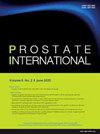前列腺癌患者的第二原发癌风险和生存率:一项全国性分析
IF 2.6
2区 医学
Q2 UROLOGY & NEPHROLOGY
引用次数: 0
摘要
目的前列腺癌(PC)的不同治疗方法可影响患者发生第二原发癌(SPCs)的风险。我们评估了原发性前列腺癌患者接受根治性前列腺切除术(RP)或放射治疗(RT)作为主要治疗后SPC的发生率和总生存期(OS)。方法使用韩国国民健康保险服务数据库,通过治疗加权逆概率法校正2002年至2018年期间所有男性PC患者在RT组和RP组之间的选择偏倚。主要终点为SPC的发生率,次要终点为SPC诊断后的OS;评估RP组和RT组之间每种SPC类型竞争风险的累积关联函数。Cox回归分析评价SPC后的OS。结果26254例PC患者中,接受RT和RP治疗的患者分别占20.3%和79.7%。PC患者发生所有SPCs的风险比一般男性人群低7%[标准化发病率比(SIR) = 0.93]。膀胱癌(SIR = 1.65)和甲状腺癌(SIR = 2.75)在两个治疗组中更常见。在10年的随访中,接受RP的患者患结肠癌的可能性低于接受RT的患者[风险差异(%)= - 0.9]。前者肺部SPC (aHRs: 0.70, P = 0.010)和结肠SPC (aHRs: 0.53, P = 0.001)后死亡风险较低,而食管SPC后死亡风险较高(aHRs: 6.9, P = 0.008)。结论原发性原发性肝癌的治疗可能影响原发性肝癌的发病率和术后生存率。原发性前列腺癌的治疗选择应指导原发性前列腺癌的后续护理和后续治疗策略。本文章由计算机程序翻译,如有差异,请以英文原文为准。
Second primary cancer risk and survival in prostate cancer patients: A nationwide analysis
Purpose
Different treatments for prostate cancer (PC) could affect a patient’s risk of developing second primary cancers (SPCs). We assessed the incidence of SPC and overall survival (OS) after SPC diagnosis in patients with PC who underwent radical prostatectomy (RP) or radiation therapy (RT) as primary treatment.
Methods
Using the National Health Insurance Service database in South Korea, all male patients with PC between 2002 and 2018 were corrected for selection bias between the RT and RP groups by inverse probability of treatment weighting. The primary outcome was the incidence of SPC, and secondary outcome was OS after SPC diagnosis; cumulative incidence functions for competing risks of each SPC type were evaluated between the RP and RT groups. Cox regression analysis evaluated OS after SPC.
Results
Among 26,254 patients with PC, 20.3% and 79.7% were treated with RT and RP, respectively. Patients with PC had a 7% lower risk of all SPCs than the general male population [standardized incidence ratio (SIR) = 0.93]. Bladder (SIR = 1.65) and thyroid (SIR = 2.75) cancers were more common in both treatment groups. At 10-year follow-up, patients who underwent RP were less likely to have colon cancer than those who underwent RT [risk difference (%) = −0.9]. The former had a lower risk of death following lung (aHRs: 0.70; P = 0.010) and colon (aHRs: 0.53; P = 0.001) SPCs and a higher risk of death following esophageal SPC (aHRs: 6.9; P = 0.008).
Conclusions
SPC incidence and OS after SPC diagnosis may be influenced by the initial PC treatment. The choice of primary treatment for PC should guide the follow-up care and subsequent treatment strategies for SPCs.
求助全文
通过发布文献求助,成功后即可免费获取论文全文。
去求助
来源期刊

Prostate International
Medicine-Urology
CiteScore
4.40
自引率
26.70%
发文量
40
审稿时长
35 days
期刊介绍:
Prostate International (Prostate Int, PI), the official English-language journal of Asian Pacific Prostate Society (APPS), is an international peer-reviewed academic journal dedicated to basic and clinical studies on prostate cancer, benign prostatic hyperplasia, prostatitis, and ...
 求助内容:
求助内容: 应助结果提醒方式:
应助结果提醒方式:


